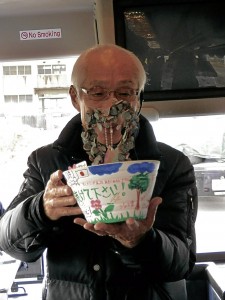
students.
After the earthquake and tsunami hit the eastern coast of Japan in March 2011, the country didn’t just want to reconstruct; it wanted to improve.
Japan now has a renewed sense of purpose, with survivors sharing what they have learned from the disaster, and one of them is reaching out to the youth by establishing the Kizuna Project. Kizuna means “bond” in Japanese.
Japanese culture has long influenced a lot of Filipinos. From sushi, animé and fashion, to Doraemon and Gundam, everyone has experienced a little of the country, one way or another. But 46 Filipino student leaders from different parts of the country were able to experience much more, thanks to the Japanese government, specifically the Embassy of Japan in the Philippines, with the cooperation of the National Youth Commission. These selected few became the first batch of Kizuna Project participants—an early Christmas gift.
First-timers
After staying overnight in Tokyo, the group rode the bullet train to Sendai, in Miyagi prefecture, two hours north of Tokyo. All of the students were first-timers in Japan, and Sendai was their first taste of a Japanese cosmopolitan city, where they got to walk around, explore and, for some, eat at local gyudon, sushi and ramen houses. The wintry weather was an added bonus.
But the most important activity was visiting the disaster-stricken area, specifically the town of Natori, just a few minutes from Sendai city. The group’s first stop was the town’s deserted high school. The first haunting images we saw were the school’s clock, stopped at 2:45, the time of the quake; a small monument dedicated to the 14 students who died in the tsunami; and a now boarded-up house beside the school, where remnants of the tsunami were still visible, including a dangling Hello Kitty figurine in the kitchen.
We were met by one of the survivors, a man in his 70s who has become a guide, and who shared with us his experience on that day. Using a translator, he explained how his once beautiful hometown was swept by the killer waves, and how they managed to escape by running to the high-school building.
We drove around the now barren land, going up a man-made hill which had been turned into a shrine. Over the horizon, we could see smoke from the disintegrating plant, where they still burned debris.
Walking around the area, we soaked in the atmosphere of eerie calmness; the Filipino students were quiet, perhaps contemplating what they were seeing. Another moving moment was when we visited the town’s local preschool; the gymnasium had been turned into a storage area for mud-soaked clothes, photos and mementos of the residents’ personal belongings.
Volunteers decided to wash these items, hoping the owners would have something despite the loss, but these items were never picked up. “Perhaps the owners are no longer alive,” our guide said.
At the end of the tour, our guide tearfully thanked us; he admitted his spirits were lifted, seeing the Filipino students listening to his stories. He ended his talk with words of wisdom: Never underestimate forces we think man is capable of overcoming.
He has lived in the town all his life, he explained, “unlike you students who go to different places,” he added in Japanese. “It’s up to you young people to tell what you have seen here, and thank you for listening to the stories of a 70-year-old man. Take care of yourselves.” Though he spoke in Japanese, one didn’t have to know the language to feel his sincerity.
The group gave him a small token, two small white pots with artwork drawn by the students, and a heart-shaped plant.
A host family
Another poignant event during the trip was when the Filipino students got to experience Japan through the eyes of the locals. Each delegate spent two days with a Japanese host family. It was like being part of the lottery; some students were lucky enough to go to Tokyo Disneyland, others were brought to the best sushi place in the area, dressed up as samurais for the day, went around to tour Tokyo, or were just part of their families’ everyday lives.
One student even had an experience when the soles of his shoes came off; he was surprised the next day when he found out his foster dad had fixed it without even telling him.
The project also included visiting schools in Japan like the Tohoku Institute of Technology in Miyagi prefecture, and Josai International University in Chiba prefecture, where the Filipino students got to mingle with people their own age.
The Japanese students were treated like celebrities, when their Filipino counterparts had fun taking pictures—in the age of Facebook, a way to break the language barrier is to just take lots of photos.
When one gets to travel abroad, one not only gets to discover foreign cultures, but also discover one’s own. The Kizuna Project not only broadened the eyes of the Filipino participants to appreciate the cultures of other countries; it made them appreciate theirs. Most of the participants came from schools all over the country, not just Manila.
Despite all of them being Filipino, there were still differences among regions and religions, but surprisingly, the students bonded. The Ilonggo delegation was the life of the party; the student from Ilocos became buddies with the student from Davao; Christian students got close to their Muslim counterparts. At the end of the 10-day trip, there were no divisions.
The Kizuna Project was not really a holiday. It was not about just sightseeing and tours. The schedule was jam-packed and could be tiring, but it was all about learning. Realizing that people can be leaders in their own way, you learn the value of helping out, of having a broader perspective on things—of living not just for yourself, but for others.